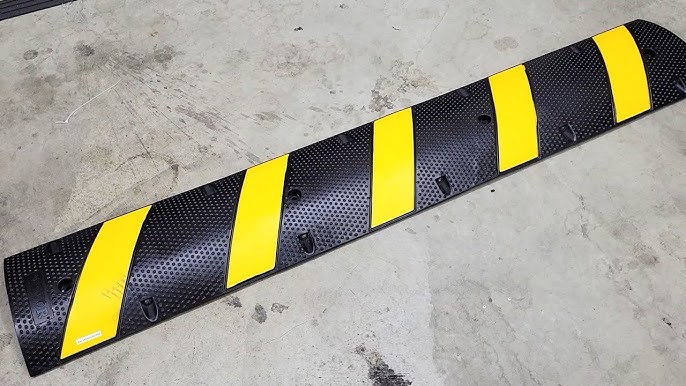Rubber speed bumps are essential tools in modern traffic management, helping to control vehicle speeds and improve safety in various locations such as residential neighborhoods, school zones, and parking lots. Unlike traditional concrete or asphalt options, rubber speed bumps are durable, cost-effective, and environmentally friendly. In this guide, we’ll explore the benefits of rubber speed bumps, how to install them, and tips for keeping them in top condition.
Understanding Rubber Speed Bumps
Speed bump rubber are made from high-quality recycled rubber, providing a durable solution to control vehicle speed in specific areas. These speed bumps are designed to slow down cars effectively while being kinder to vehicles compared to their more rigid counterparts. Rubber speed bumps are flexible and can be used on various surfaces, making them suitable for diverse locations and weather conditions.
Key Benefits of Rubber Speed Bumps
Rubber speed bumps have several advantages over traditional materials, which explains their increasing popularity. Here are some notable benefits:
1. Durability and Longevity
Rubber speed bumps are built to withstand harsh conditions and heavy traffic flow. They are highly resistant to cracking, fading, or chipping, ensuring a longer lifespan than traditional concrete or asphalt speed bumps. This durability makes them a reliable option for busy areas.
2. Environmentally Friendly
Many rubber speed bumps are made from recycled rubber, making them an eco-friendly choice. By repurposing used materials, they reduce waste and have a lower environmental impact compared to concrete speed bumps, which require significant energy to produce.
3. Comfortable for Vehicles
Rubber speed bumps have a slightly flexible structure, which makes them less jarring for vehicles compared to concrete or metal options. This helps reduce the risk of vehicle damage while still effectively controlling speed, creating a safer driving experience.
4. Easy Installation and Portability
Unlike traditional speed bumps that require significant time and effort to install, rubber speed bumps can be set up in just a few hours. They’re often secured with bolts or adhesives and can be removed or relocated as needed, providing flexibility for temporary installations or adjustments.
5. Enhanced Visibility for Safety
Rubber speed bumps often come with built-in reflectors or reflective tape to improve visibility in low light or poor weather conditions. This visibility helps drivers recognize the speed bump in advance, promoting safer driving behaviors.
Common Applications of Rubber Speed Bumps
Rubber speed bumps are highly versatile and can be used in various settings:
- Residential Areas: Effective in slowing down traffic to protect pedestrians.
- School Zones: Helps maintain safe driving speeds in areas with high foot traffic.
- Parking Lots: Used to prevent accidents and ensure orderly vehicle flow.
- Hospitals and Emergency Zones: Helps control speed while minimizing jarring for emergency vehicles.
How to Install Rubber Speed Bumps
Installing rubber speed bumps is a simple process, requiring minimal tools and effort. Here’s a step-by-step guide:
Step 1: Choose the Location
Identify the area where the speed bump is needed. Mark the spot to ensure it aligns properly with the road’s layout and is free from obstructions. This location should be on a level surface to provide even contact for installation.
Step 2: Clean the Installation Area
Ensure the surface is clean, removing any dirt, debris, or other substances. A clean surface ensures that the adhesive or bolts will hold the speed bump firmly in place.
Step 3: Place and Align the Speed Bump
Position the rubber speed bump on the marked area, making sure it’s properly aligned. Many rubber speed bumps come with pre-drilled holes for easy securing.
Step 4: Secure the Speed Bump
Depending on the manufacturer’s instructions, use either bolts or adhesive to anchor the speed bump in place. Bolts are commonly used for a more permanent installation, while adhesive can be used for temporary placement.
Step 5: Add Reflective Markings if Necessary
If the speed bump does not have built-in reflective markers, add reflective tape or paint to improve visibility, especially for nighttime or low-visibility conditions.
Maintenance Tips for Rubber Speed Bumps
Proper maintenance ensures that rubber speed bumps remain effective and safe for use over time. Here are some helpful maintenance tips:
Regular Inspections
Check the speed bumps periodically for signs of wear, such as fading, loosening, or surface damage. Inspecting the bolts and adhesive is essential to keep the speed bump securely in place.
Remove Debris and Clean the Area
Dirt, leaves, and other debris can accumulate around speed bumps, reducing their visibility. Clean the speed bump and surrounding area regularly to maintain its appearance and ensure drivers can see it clearly.
Replace Reflective Tape or Markings as Needed
Reflective materials may wear out over time due to exposure to weather. Replace reflective tape or reapply paint as needed to keep the speed bump highly visible and safe.
Repair or Replace Damaged Sections
If you notice any significant damage, consider replacing the affected section. Rubber speed bumps are often modular, so damaged parts can be swapped out without removing the entire bump, making maintenance simpler.
Rubber Speed Bumps vs. Traditional Speed Bumps
Rubber speed bumps offer unique advantages over traditional concrete or asphalt options. Here are some key comparisons:
- Cost and Installation Time: Rubber speed bumps are more affordable and quicker to install, reducing both labor costs and installation time.
- Environmental Impact: Made from recycled rubber, they have a lower environmental impact compared to concrete, which requires substantial resources to produce.
- Portability: Rubber speed bumps can be easily removed and relocated, making them an ideal choice for temporary traffic management, unlike concrete speed bumps that are permanent.
Conclusion
Rubber speed bumps provide an effective, eco-friendly, and durable solution for controlling traffic speeds and enhancing safety in various settings. With easy installation, low maintenance, and high durability, they are an excellent choice for residential and commercial applications alike. By following proper installation and maintenance steps, rubber speed bumps can remain functional and effective for years, creating a safer environment for both drivers and pedestrians.


